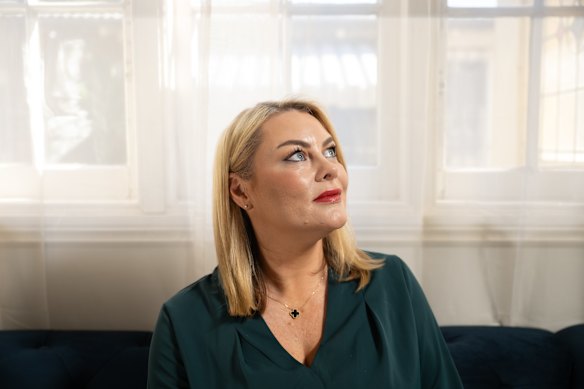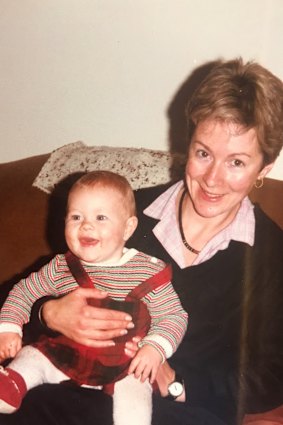Up to 17 million people have been conceived via IVF since the first IVF baby was born over 40 years ago, a world-first analysis has revealed.
But despite the exponential rise in IVF families, the medical treatment is no panacea for nosediving fertility rates, or the common misperception that IVF can turn back the biological clock.

Rebecca Featherstone was among the first IVF babies to be conceived in the 1980s. Credit: Nick Moir
An estimated 10 to 13 million IVF-conceived babies were born between 1978 – when the first IVF child, Louise Brown, was born in England – and 2018, according to an analysis of data from fertility clinics and regional registries across the world by the International Committee Monitoring Assisted Reproductive Technologies.
Sydneysider Rebecca Featherstone is among the first generation of “IVFlings”. She was conceived in 1982 at Bourn Hall in Cambridge – the same fertility clinic as Brown.

Rebecca Featherstone as a baby, with her late mother, Judy.
“My mum and dad’s doctors were Professor Patrick Steptoe and Sir Robert Edwards – the pioneers of IVF,” said Featherstone, who now works as an IVF advocate. Back then, the chance of having a baby through this experimental new technique was about 5 per cent.
“What’s fascinating is that people conceived through IVF have gone on to have their own families, so it has created a whole other generation that would never have been here if it wasn’t for that science.”
Featherstone’s naturally conceived daughter, 14, and son, 12, are part of that generation.
“I look at my kids and think: wow, if it weren’t for IVF, they wouldn’t be here either,” she said.
The study, published in Fertility and Sterility, used statistical estimates to fill in the gaps left by clinics that had not reported their results.
Preliminary data from 2019 to 2024 indicates that another 3 to 4 million IVF babies have been born since the study’s 2018 cut-off, said Professor Georgina Chambers, custodian of the Australian and New Zealand Assisted Reproductive Technology Database, and director of UNSW’s National Perinatal Epidemiology and Statistics Unit.
As IVF has become an increasingly effective and safe mainstream medical treatment, many countries have turned to IVF to support pronatalist policies, Chambers said.
“You’ve got governments in places like Japan, China and South Korea offering a lot of financial support for IVF treatment to improve fertility rates,” Chambers said.
Asia reported just 8 per cent of IVF births in the 1990s, rapidly accelerating in the 2000s to contribute 33 per cent by 2018.
Australia’s declining fertility rate was the opening gambit in a road map for Australia’s national fertility policy, commissioned by the Fertility Society of Australia and New Zealand and co-authored by former federal health minister Greg Hunt.
The trouble is, IVF barely makes a dent in declining fertility rates, said Robert Norman, a professor of reproductive and periconceptual medicine at the University of Adelaide.
“IVF is a fantastic medical technology for infertility … it’s not the great hope for the future of fertility rates,” he said.
The replacement fertility rate – the average number of children to have to maintain a stable population size (excluding migration) – is typically 2.1 births per woman.
Countries including South Korea (0.75), Singapore (0.97), Japan (1.15) and China (1) are well below that level.
While a record 17,963 IVF babies were born in Australia in 2022, Australia’s fertility rate was 1.5 in 2023, and may have fallen to 1.4.
IVF accounts for about 5 per cent of Australia’s total fertility rate.
“[Some in the] IVF industry will point to fertility rates and argue that we need more IVF, that it needs to be more accessible and all women should have the opportunity to freeze their eggs. But it won’t make a difference if society is geared up socially and economically against having children,” Norman said.
Although the chance of having a baby for women starting IVF after 42 is remote, Norman said it was “not unusual to have people turning up in their 40s and say: ‘I’m ready to have children now.’”
Chambers said statistics like “one child is born via IVF every 35 seconds somewhere in the world” and “one in 16 children in Australia are born after IVF”, may suggest IVF will solve Australia’s declining fertility rate, but there’s a risk it can have an adverse, reverse effect.
“If people think ‘I can turn to IVF when I’m older’, they may potentially postpone having children. IVF is less successful the older you get, and we know that the later you have children, the fewer children you will have,” she said.
“Overall, it doesn’t have a huge impact, but it does increase the age-specific fertility rate of older women – aged over 33 – which only partially compensates for declining fertility rates in younger women.”
Featherstone co-founded Fertility Matters with Australia’s first IVF baby, Candice Thum (née Reed), to develop free school programs designed to educate teenagers about fertility – most notably that it declines with age, and the role of both sexes – after being struck by how little their adult friends knew about fertility health.
“These are really smart young men and women who didn’t know the obvious statistics and information,” Featherstone said.
It has been a year of significant reputational damage for Australia’s IVF industry.
In June, health ministers launched a rapid review of the IVF sector after two devastating embryo transfer errors at Monash IVF clinics in Brisbane and Melbourne.
Meanwhile, patients of IVF provider Genea had their information published on the dark web after cybercriminals targeted the company in February.
“The IVF industry generates $820 million per year in revenue,” Chambers said.
“The government pays about two-thirds of that, and part of that should go towards proper auditing and regulation.”
The Morning Edition newsletter is our guide to the day’s most important and interesting stories, analysis and insights. Sign up here.